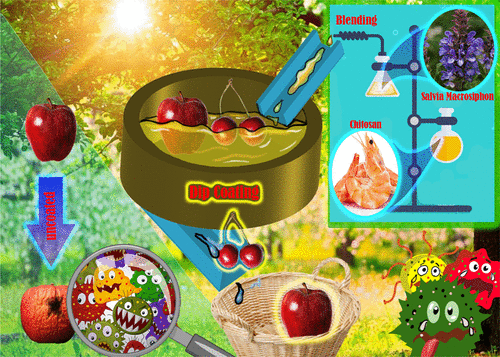当前位置:
X-MOL 学术
›
ACS Sustain. Chem. Eng.
›
论文详情
Our official English website, www.x-mol.net, welcomes your feedback! (Note: you will need to create a separate account there.)
Development and Characterization of Salvia macrosiphon/Chitosan Edible Films
ACS Sustainable Chemistry & Engineering ( IF 8.4 ) Pub Date : 2020-01-13 , DOI: 10.1021/acssuschemeng.9b05894 Saeed Davoodi 1 , Seyed Mohammad Davachi 1, 2 , Aida Ghorbani Golkhajeh 1 , Azadeh Sadat Shekarabi 3 , Alireza Abbaspourrad 2
ACS Sustainable Chemistry & Engineering ( IF 8.4 ) Pub Date : 2020-01-13 , DOI: 10.1021/acssuschemeng.9b05894 Saeed Davoodi 1 , Seyed Mohammad Davachi 1, 2 , Aida Ghorbani Golkhajeh 1 , Azadeh Sadat Shekarabi 3 , Alireza Abbaspourrad 2
Affiliation

|
With the aim of manufacturing environmentally friendly and antimicrobial edible films for packaging applications, we explored biofilms based on a blend of Salvia macrosiphon seed mucilage (SSM) and chitosan, which is studied for the first time, prepared at different ratios by drying of the colloidal solution at the end. It was observed that hydrogen bonding occurs between these two carbohydrates, and at higher concentrations of chitosan, it dominates as the matrix. The addition of chitosan to SSM leads to conservable improvement of the mechanical properties compared to the neat SSM, with 65% enhancement of the tensile strength. Thermal property studies of prepared blends showed a single glass transition temperature, which is indicative of good miscibility in all temperature ranges. Moreover, the blended biofilms showed excellent barrier properties against water in comparison with neat SSM as the addition of chitosan leads to greater hydrophobicity. The chitosan also improved the barrier properties of SSM against UV light while also enhancing its transparency (at 600 nm) at lower concentrations. Morphological studies clearly showed the dispersion of chitosan in the SSM matrix and a corresponding increase in roughness of the biofilms. Additionally, the antibacterial activity of the biofilms improved with increasing chitosan content without using any antimicrobial agent. As a result of these combined characteristics, the SSM/chitosan biofilms are appropriate candidates for edible and eco-friendly packaging applications as they can keep fruits more fresh in an eco-friendly sustainable way and reduce the fruit waste.
中文翻译:

丹参/壳聚糖可食性膜的研制与表征
为了生产用于包装的环保和抗菌可食性薄膜,我们探索了基于丹参大虹吸混合物的生物薄膜。首次研究的种子粘液(SSM)和壳聚糖是通过最后干燥胶体溶液以不同的比例制备的。观察到在这两种碳水化合物之间发生氢键,并且在较高的壳聚糖浓度下,氢键占主导地位。与纯SSM相比,将壳聚糖添加到SSM中可导致机械性能的保守改善,拉伸强度可提高65%。制备的共混物的热性能研究显示单一的玻璃化转变温度,表明在所有温度范围内均具有良好的混溶性。此外,与纯SSM相比,混合的生物膜对水表现出优异的阻隔性能,因为添加壳聚糖会导致更大的疏水性。壳聚糖还改善了SSM对紫外线的阻隔性能,同时在较低浓度下也增强了其透明度(在600 nm)。形态学研究清楚地表明,壳聚糖在SSM基质中的分散和生物膜粗糙度的相应增加。另外,在不使用任何抗微生物剂的情况下,随着壳聚糖含量的增加,生物膜的抗菌活性得到改善。由于这些综合特性,SSM /壳聚糖生物膜是可食用和生态友好型包装应用的合适候选者,因为它们可以以生态友好的可持续方式保持水果更新鲜,并减少了水果浪费。形态学研究清楚地表明,壳聚糖在SSM基质中的分散和生物膜粗糙度的相应增加。另外,在不使用任何抗微生物剂的情况下,随着壳聚糖含量的增加,生物膜的抗菌活性得到改善。由于这些综合特性,SSM /壳聚糖生物膜是可食用和生态友好型包装应用的合适候选者,因为它们可以以生态友好的可持续方式保持水果更新鲜,并减少了水果浪费。形态学研究清楚地表明,壳聚糖在SSM基质中的分散和生物膜粗糙度的相应增加。另外,在不使用任何抗微生物剂的情况下,随着壳聚糖含量的增加,生物膜的抗菌活性得到改善。由于这些综合特性,SSM /壳聚糖生物膜是可食用和生态友好型包装应用的合适候选者,因为它们可以以生态友好的可持续方式保持水果更新鲜,并减少了水果浪费。
更新日期:2020-01-14
中文翻译:

丹参/壳聚糖可食性膜的研制与表征
为了生产用于包装的环保和抗菌可食性薄膜,我们探索了基于丹参大虹吸混合物的生物薄膜。首次研究的种子粘液(SSM)和壳聚糖是通过最后干燥胶体溶液以不同的比例制备的。观察到在这两种碳水化合物之间发生氢键,并且在较高的壳聚糖浓度下,氢键占主导地位。与纯SSM相比,将壳聚糖添加到SSM中可导致机械性能的保守改善,拉伸强度可提高65%。制备的共混物的热性能研究显示单一的玻璃化转变温度,表明在所有温度范围内均具有良好的混溶性。此外,与纯SSM相比,混合的生物膜对水表现出优异的阻隔性能,因为添加壳聚糖会导致更大的疏水性。壳聚糖还改善了SSM对紫外线的阻隔性能,同时在较低浓度下也增强了其透明度(在600 nm)。形态学研究清楚地表明,壳聚糖在SSM基质中的分散和生物膜粗糙度的相应增加。另外,在不使用任何抗微生物剂的情况下,随着壳聚糖含量的增加,生物膜的抗菌活性得到改善。由于这些综合特性,SSM /壳聚糖生物膜是可食用和生态友好型包装应用的合适候选者,因为它们可以以生态友好的可持续方式保持水果更新鲜,并减少了水果浪费。形态学研究清楚地表明,壳聚糖在SSM基质中的分散和生物膜粗糙度的相应增加。另外,在不使用任何抗微生物剂的情况下,随着壳聚糖含量的增加,生物膜的抗菌活性得到改善。由于这些综合特性,SSM /壳聚糖生物膜是可食用和生态友好型包装应用的合适候选者,因为它们可以以生态友好的可持续方式保持水果更新鲜,并减少了水果浪费。形态学研究清楚地表明,壳聚糖在SSM基质中的分散和生物膜粗糙度的相应增加。另外,在不使用任何抗微生物剂的情况下,随着壳聚糖含量的增加,生物膜的抗菌活性得到改善。由于这些综合特性,SSM /壳聚糖生物膜是可食用和生态友好型包装应用的合适候选者,因为它们可以以生态友好的可持续方式保持水果更新鲜,并减少了水果浪费。


























 京公网安备 11010802027423号
京公网安备 11010802027423号